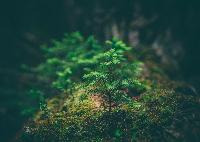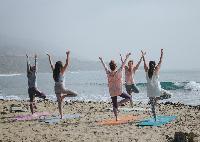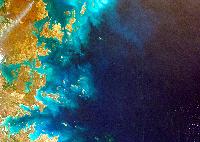From hiking and biking in nature to dinner and board games by candlelight, these Earth Day activities are fun for all ages
The first Earth Day took place in 1970, which is often considered the start of the modern environmental movement. Now, more than a billion people mark Earth Day on April 22 each year by taking actions both big and small. Here are some easy eco-friendly things you can do to help the environment—plus a few suggestions of ways to slow down and appreciate this planet’s abundant natural beauty.
- Plant a tree. It’s a classic Earth Day activity for a reason: Trees are great for the environment, doing everything from providing food and shelter for wildlife to improving air quality for everyone.
 Photo by Matthew Smith on Unsplash
Photo by Matthew Smith on Unsplash - Challenge yourself not to use any electricity for a day.
- Watch a mesmerizing livestream of creatures such as the jellyfish at Monterey Bay Aquarium in California or hippos, giraffes, zebras and lions at the Mpala Research Centre’s watering hole in Kenya.
- Read The Lorax by Dr. Seuss. Published in 1971, this classic children’s book was decades ahead of its time. Written in Dr. Seuss’s inimitable tongue-twisting rhymes, the story tells of a businessman who destroys an entire forest and drives away the animals that live there in order to sell products that no one needs, all while ignoring repeated warnings from the Lorax, who speaks on behalf of the trees.
- Eat dinner by candlelight, followed by a few board games or card games in the soothing flickering light.
- Try shinrin-yoku, which is a Japanese concept that translates to forest bathing or forest therapy. It’s the idea of simply being in the great outdoors and mindfully connecting to nature, using all five of our senses.
- Clean up your act! Try a new green product, like these innovative zero-waste laundry strips from eco-friendly brand, Tru Earth.
- Cut up an old garment, and use the fabric to sew something new.
- Start planting a garden. Whether that means one cilantro plant in your apartment window, a plot in a community garden or an entire yard depends on your personal circumstances, but the key thing is to start growing your own food.
- Make a bird feeder using a pinecone, peanut butter and birdseed.
- Visit a farmers’ market. Don’t forget to bring your own fabric shopping bags and reusable containers to tote home your treasures.
 Photo by Anne Preble on Unsplash
Photo by Anne Preble on Unsplash - Donate to a charity focused on the saving the planet, such as the David Suzuki Foundation or Sierra Club.
- Get creative with used cardboard, and build a castle for your kids (or perhaps your cat).
- Watch a documentary about this beautiful planet, to remind yourself what we all should be working hard to save. You can’t go wrong with the original Planet Earth series narrated by David Attenborough.
- Go for a walk or a bike ride. Stop regularly along the way to smell the flowers—literally.
- Eat some weeds! Many weeds are edible, including dandelions, stinging nettles, clover, purslane and chickweed. Embrace “lazy gardening” by making use of the hardy, nutritious, vitamin-packed weeds that are growing in your own backyard.
- If you’re feeling really adventurous, eat some insects! Crickets, mealworms, grasshoppers, scorpions, locusts and ants are good sources of protein, without the high environmental cost of animal protein, and many North American companies promote entomophagy (eating insects). A good starting point is crickets, which can be purchased roasted whole, ground into powder or baked into chips, pasta, protein bars and more.
- Go for a hike in the mountains, and take deep breaths of the fresh mountain air.
- Visit your local library, either in person or online. A wealth of resources and entertainment options are available at libraries, all free of charge.
- Sign up for a course on ecology or environmental management, or get more hands-on by registering for a class on composting, gardening, beekeeping, sewing or vegan cooking.
- Camp outside under the stars, whether in a forest, campground or yard—or even on an apartment patio.
 Photo by Dominik Jirovský on Unsplash
Photo by Dominik Jirovský on Unsplash - Clean out a drawer or a closet, and donate anything you don’t need to charity.
- Join a local cleanup of a beach or park. If you can’t find one, start one yourself.
- Start a challenge with your friends to see who can grow the most fruits and veggies to donate to the food bank. You don’t need a yard—a patio garden or windowsill garden will work just fine.
- Make a wine cork board using corks saved from wine bottles. (The best part is drinking enough wine to save up all the corks.)
- Unravel an old sweater and repurpose the wool to knit something new.
- Do a scavenger hunt for things found in nature, from maple leaves to cherry blossoms.
- Use sidewalk chalk to write fun and encouraging Earth Day messages outside your home. Choose chalk that has been colored using vegetables instead of anything toxic.
- Do an earth-friendly food challenge: For one day, eat only vegan foods, or foods with zero plastic packaging, or foods grown within 100 miles of your home. If you enjoy the day-long challenge, try extending or expanding it.
- Do an outdoor yoga class, maybe one featuring goats, puppies, dogs or bunnies.
 Photo by Kaylee Garrett on Unsplash
Photo by Kaylee Garrett on Unsplash - Adopt an animal (symbolically) from an organization such as the World Wildlife Fund, which uses the money raised to help protect animals in the wild.
- Go bird-watching.
- Make reusable beeswax wraps, and stop using single-use plastic wrap for your food.
- Take the plunge by going for a swim in the ocean, a river or a lake. Swimming, especially outdoors, is a natural stress-reliever that can feel almost like meditation.
- Start a travelling swap bag filled with toys, clothes, books, DVDs or whatever you’d like to trade with like-minded people.
- Try visible mending. Inspired by the Japanese concept of sashiko, it’s the art of fixing clothing in an obvious way. Instead of viewing a rip or stain as a mistake that needs to be hidden, it’s seen as an opportunity to make a garment unique, strengthening it and adding beauty in the process—the exact opposite of fast, disposable fashion.
- Go for a picnic. If the weather won’t cooperate, have a picnic on your living room floor.
- Build a hotel for solitary bees. These non-aggressive wild bees don’t live in colonies or produce honey, but they’re powerful pollinators and therefore extremely beneficial for the environment. Give them a place to rest in your yard by constructing a simple hotel out of materials such as hollow bamboo stalks and wood with holes drilled in it.
- Photograph something beautiful in nature.
- Plant wildflowers that are native to your area. Native wildflowers are good for bees and wildlife, and they’re already conditioned to thrive in a specific area without needing additional water, fertilizer or pesticides.
- Check out stunning photos taken from outer space. They’re a good reminder of how small and fragile this planet really is—and how everything is interconnected.
 Photo by NASA on Unsplash
Photo by NASA on Unsplash





